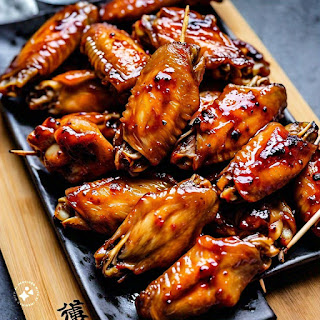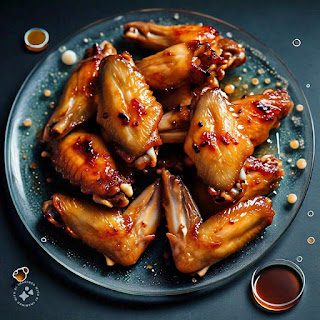The Cultural Significance of Teriyaki Baked Wings.
Teriyaki baked wings are a delightful fusion of Japanese and American flavors, combining the sticky sweetness of teriyaki sauce with the crispy texture of baked chicken wings. This dish is a crowd-pleaser, perfect for gatherings, game nights, or simply as a satisfying snack. In this comprehensive guide, we'll explore everything you need to know about making teriyaki baked wings, from selecting the right ingredients to mastering the cooking technique.
} };
Table of Contents
1. Introduction to Teriyaki Baked Wings
2. Origins of Teriyaki Sauce
3. Evolution of Baked Wings in American Cuisine
4. Fusion of Culinary Traditions
5. Symbolism and Social Significance
6. Teriyaki Baked Wings in Popular Culture
7. Culinary Tourism and Globalization
8. Conclusion
1. Introduction to Teriyaki Baked Wings
Teriyaki baked wings are a mouthwatering dish that combines tender chicken wings with a sticky, sweet, and savory teriyaki glaze. The wings are typically marinated in a mixture of soy sauce, sugar, ginger, garlic, and other seasonings, then baked until golden brown and caramelized.
This culinary creation offers a delightful contrast of flavors and textures, with the richness of the chicken complemented by the tangy sweetness of the teriyaki sauce.
2. Origins of Teriyaki Sauce
To understand the cultural significance of teriyaki baked wings, it's essential to explore the origins of teriyaki sauce. Teriyaki is a cooking technique in Japanese cuisine that involves grilling or broiling meat or fish with a glaze made from soy sauce, mirin (sweet rice wine), and sugar. The word "teriyaki" is derived from the Japanese terms "teri" (glaze) and "yaki" (grilled or broiled), reflecting the method of preparation.
The origins of teriyaki sauce can be traced back to the Edo period in Japan (1603-1868), where it was originally used to preserve and flavor fish. Over time, the sauce evolved, becoming a popular marinade and glaze for various meats, including chicken, beef, and pork. Today, teriyaki sauce is a staple condiment in Japanese cuisine, enjoyed in dishes such as teriyaki chicken, teriyaki salmon, and teriyaki beef.
3. Evolution of Baked Wings in American Cuisine
In American cuisine, chicken wings have a long and storied history, dating back to the 1960s when they were first introduced as a bar snack at the Anchor Bar in Buffalo, New York. Traditionally, chicken wings were deep-fried and tossed in a spicy sauce made from hot sauce and butter, resulting in the iconic Buffalo wings.
wings soared, and they became a beloved finger food enjoyed at parties, sporting events, and casual gatherings across the United States. However, concerns about health and wellness prompted a shift towards healthier cooking methods, leading to the rise of baked wings as an alternative to traditional fried wings.
Baking chicken wings offers several advantages over frying, including reduced fat content, fewer calories, and a lighter, crispier texture. Baked wings can also be easily customized with a variety of seasonings, sauces, and glazes, making them a versatile and flavorful option for home cooks and food enthusiasts alike.
4. Fusion of Culinary Traditions
Teriyaki baked wings represent a fusion of Japanese and American culinary traditions, blending the flavors and techniques of both cultures into a single, harmonious dish. This fusion is evident in the marriage of teriyaki sauce—a quintessential Japanese condiment—with the beloved American staple of chicken wings.
The combination of teriyaki sauce with baked wings creates a unique flavor profile that appeals to a wide range of palates, offering a balance of sweet, savory, and umami notes. The sticky glaze caramelizes as the wings bake, resulting in a glossy, golden-brown coating that enhances the richness of the chicken.
The fusion of culinary traditions extends beyond the ingredients and preparation methods to encompass cultural influences and culinary innovation. Teriyaki baked wings exemplify the creativity and adaptability of chefs and home cooks who draw inspiration from diverse cuisines to create new and exciting dishes that reflect the multicultural landscape of modern society
5. Symbolism and Social Significance
Teriyaki baked wings hold symbolic significance beyond their culinary appeal, serving as a representation of cultural diversity, inclusivity, and unity. In a world where food is often used to divide people along racial, ethnic, and cultural lines, dishes like teriyaki baked wings have the power to bring people together, fostering understanding, appreciation, and mutual respect.
he act of sharing a meal—whether it's a plate of teriyaki baked wings at a backyard barbecue or a family dinner—creates opportunities for cross-cultural exchange and dialogue. Food has the ability to transcend language barriers and cultural differences, allowing people from diverse backgrounds to connect and bond over a shared love of delicious cuisine.
Furthermore, teriyaki baked wings celebrate the contributions of immigrants and diaspora communities to the culinary landscape of their adopted countries. They embody the spirit of cultural exchange and collaboration, highlighting the ways in which food serves as a bridge between cultures, generations, and continents.
6. Teriyaki Baked Wings in Popular Culture
Teriyaki baked wings have become increasingly popular in mainstream culture, appearing on restaurant menus, cooking shows, and social media platforms around the world. Their irresistible combination of flavors and textures has made them a favorite among food enthusiasts and influencers, who eagerly share photos, recipes, and reviews online.
In addition to their culinary appeal, teriyaki baked wings have also made their mark in popular culture through references in music, television, and film. They are often featured in scenes set in casual dining establishments, sports bars, and family gatherings, where they serve as a symbol of camaraderie,
Furthermore, teriyaki baked wings have inspired countless variations and spin-offs, including teriyaki chicken pizza, teriyaki-glazed burgers, and teriyaki chicken sandwiches. These creative reinterpretations pay homage to the original dish while offering new and exciting ways to enjoy its distinctive flavors.
7. Culinary Tourism and Globalization
Teriyaki baked wings have become a draw for culinary tourists seeking to explore the intersection of Japanese and American cuisine. Restaurants, food trucks, and eateries around the world offer their own interpretations of this beloved dish, showcasing regional ingredients, cooking techniques, and flavor profiles.
The popularity of teriyaki baked wings has also been fueled by globalization, as the spread of information and communication technologies has facilitated the exchange of culinary ideas and practices across borders. Social media platforms, food blogs, and online communities provide a platform for chefs, food enthusiasts, and home cooks to share their passion for cooking and discover new and exciting recipes from around the world.
As a result, teriyaki baked wings have transcended geographical boundaries to become a global culinary phenomenon, beloved by people of all ages, backgrounds, and cultural affiliations. Whether enjoyed in a bustling metropolis or a small-town diner, teriyaki baked wings offer a taste of the rich tapestry of flavors, traditions, and stories that make up our interconnected world.
8. Conclusion
In conclusion, teriyaki baked wings are more than just a delicious dish—they are a symbol of cultural exchange, culinary innovation, and social connection. By bringing together the flavors of Japan and America, teriyaki baked wings embody the spirit of diversity, inclusivity, and unity that defines our global society.
aa
As we continue to explore and celebrate the rich tapestry of culinary traditions from around the world, dishes like teriyaki baked wings remind us of the power of food to transcend borders, forge connections, and create meaningful experiences that bring joy and nourishment to our lives. So the next time you bite into a tender, flavorful wing glazed with sticky teriyaki sauce, take a moment to savor the flavors and appreciate the cultural journey that brought it to your plate.he Cultural Significance of Teriyaki Baked Wings.

.jpg)







0 Comments